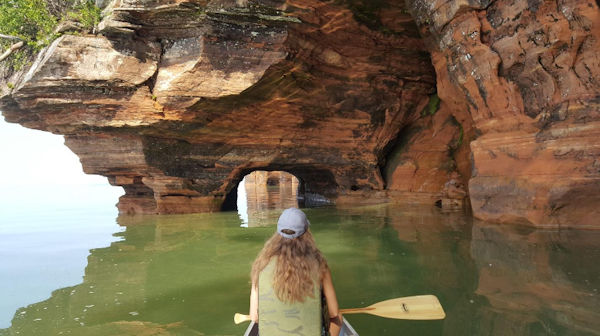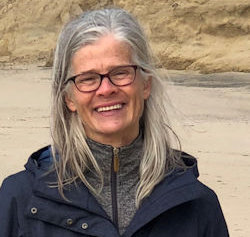SEJournal Online is the digital news magazine of the Society of Environmental Journalists. Learn more about SEJournal Online, including submission, subscription and advertising information.
 |
| A paddler checks out an algal bloom on Lake Superior at the sea caves near Cornucopia, Wisc. Photo: James Dexter via Great Lakes Now. |
FEJ StoryLog: Grantee Wades Into Surprising Blue-Green Algae Problem
By Sharon Oosthoek
Scrolling through my Twitter feed one fall evening in 2019, a post caught my eye: “Blue-Green Algae Documented In Superior’s Canadian Waters – A First?”
Like many Great Lakes watchers, I’d heard about the previous summer’s massive blue-green algal bloom on Superior’s southern shore in the United States. It was the largest ever recorded on the lake — 100 kilometers of water turned opaque green.
Superior, the coldest and deepest of the
Great Lakes, was long thought immune to the
blooms that have plagued warm, shallow Lake Erie.
That bloom was a bit of a shock, even to scientists who study the lake. Superior, the coldest and deepest of the Great Lakes, was long thought immune to the blooms that have plagued warm, shallow Lake Erie. Now this tweet from InfoSuperior, a Thunder Bay, Ontario-based research network, was suggesting far northern reaches of the lake were just as vulnerable.
Curious, I tracked down the kayaker who spotted the bloom and I discovered he knew what he was talking about. Jim Bailey had just retired as coordinator of a local government office tasked with identifying and controlling sources of pollution.
“I’ve lived on the lake my entire life and I’d never seen algae before,” Bailey told me. “I knew if it was algae, it would be a landmark and not a good one.”
It turned out that it was indeed blue-green algae.
I had questions: Was this the beginning of Lake Erie-type massive blooms? The kind that leads to fish-killing oxygen-deprived dead zones and fouls municipal water supplies? How might this affect an economy heavily reliant on marketing its pristine waters? What about locals’ perceptions of the big, beautiful lake they call Gitche Gumee?
I reached out to Great Lakes researchers on both sides of the border and discovered they had the same questions, plus others I hadn’t thought of — how winter conditions affect summer blooms, and why only certain parts of the lake have blooms. These researchers were also starting to come up with answers.
Grant good, pandemic bad
That’s when I pitched the idea to Sandra Svoboda, the program director at Detroit Public Television’s channel Great Lakes Now, or GLN. She suggested we co-apply to the Society of Environmental Journalists for a grant from the Fund for Environmental Journalism. It would allow her to pay for a deep dive into the topic — two web-based features, a video segment, online engagement and a curriculum package for schools.
We got the grant — yea! But by then, we were in the middle of a pandemic — boo!
Travel restrictions meant I couldn’t go from my home in Toronto to Duluth and Ashland in Minnesota for on-site reporting and to act as a field producer. Still, I reported and wrote two stories — one explaining how climate change is affecting Superior in the winter and the other in the summer. I also contributed to the preproduction planning, the segment outline and the script, and took part in a live audience Q&A.
Without on-the-ground reporting, I knew
I would be challenged to create a
sense of place and an evocative narrative.
Without on-the-ground reporting, I knew I would be challenged to create a sense of place and an evocative narrative. I did as many interviews as possible via video to develop a good rapport with sources.
I also asked them to recount in detail various events: What it’s like to kayak through a bloom, and what the equipment for water temperature monitoring looks like and how unwieldy it is, as well as to explain their level of frustration over inconclusive experiments.
Fun with metrics
The grant required us to report back to SEJ on audience engagement, which as a freelancer, I don’t often get to see.
 |
| Facebook Watch Party event with Sandra Svoboda (left), program director at Detroit Public Television’s Great Lakes Now channel, and freelance science journalist Sharon Oosthoek. Click to enlarge. |
I appreciated the insight into the metrics. For example, we were able to tell SEJ that the “Lake Superior Winter” piece, published on March 10, 2021, had 1,759 views. “Lake Superior Summer,” published August 24, 2021, had 12,760 page views, making it the fourth-most-read article the entire calendar year on GLN’s website in the roughly three months since it was published.
I also learned the video episode of the GLN monthly program in which “Superior Blooms” was included aired at least 29 times between Aug. 25 and Nov. 26, 2021, on PBS stations in cities across Michigan, and in New York, Ohio, Wisconsin, Indiana.
It was also fun to see my piece reworked by curriculum experts into educational materials introducing students to eutrophication by helping them understand the reasons behind Superior’s unusual algal blooms and how toxic algal blooms affect the wider Great Lakes.
Tips for grant applications
My advice for getting grants is much like the advice freelancers give when asked how to pitch a story. When I want to write for a publication, I read the publication. When I apply for a grant, I read the pieces that were successful.
And just like a good pitch, I think a good grant application should tell a story. Show the judges you have what it takes to create an engaging narrative.
My last tip may seem blindingly obvious, but having helped judge projects for funding, I know it’s not: Pay close attention to what the grant application asks for and make sure you answer all questions and provide all required documents.
 |
[Editor’s Note: For more on algae, see our Issue Backgrounder, “Algae — Society’s Big, Green … and Emerging Menace,” a TipSheet on “Harmful Algal Blooms Plague Polluted Summer Waters” and a BookShelf review of “The Death and Life of the Great Lakes.” Plus, track the latest algae news with headlines from EJToday.]
Sharon Oosthoek is a freelance science journalist based in Victoria, British Columbia. Her writing can be found in New Scientist, Canadian Geographic, Maclean’s, The Globe and Mail, cbc.ca, Science News and Chemical & Engineering News.
Oosthoek is also a contributing writer with Detroit Public Television’s Great Lakes Now bureau, and with Science News for Students. She’s won several journalism awards, most recently a 2019 AAAS Kavli Science Journalism Award for children’s science writing.
* From the weekly news magazine SEJournal Online, Vol. 7, No. 16. Content from each new issue of SEJournal Online is available to the public via the SEJournal Online main page. Subscribe to the e-newsletter here. And see past issues of the SEJournal archived here.













 Advertisement
Advertisement 



